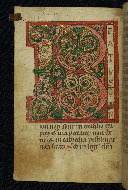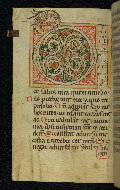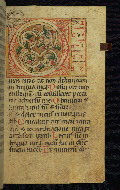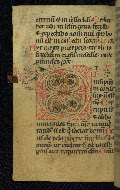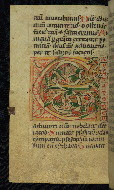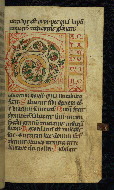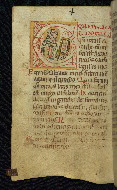Home > Digitized Walters Manuscripts
This document is a tranformation of a TEI P5 XML manuscript description incorporating images. If you have trouble reading special or non-Latin characters on this page, please make sure you have appropriate Unicode fonts installed and an up-to-date web browser.
Walters Ms. W.25, Premonstratensian Psalter
Browse images (Browse images in a new window) | TEI in XML format
W.25
Premonstratensian Psalter
This late twelfth- or early thirteenth-century Psalter was made for a female supplicant, and is of Premonstratensian use. Created and used in Rhineland, Germany, it remained there until the French Revolution, after which it was eventually acquired by the English book collector Sir Thomas Phillipps. The Psalter is liturgical, and therefore has eight divisions for the liturgical week, as well as the usual tripartite divisions. Each of these major psalms is marked by large lively inhabited or foliate initials. Early added prayers on the first and last blank pages, as well as occasional marginal prayers and notes in a variety of hands, attest to the manuscript's use through time.
Late 12th or early 13th century CE
Rhineland, Germany
Book
Devotional
The primary language in this manuscript is Latin.
Parchment
Somewhat yellowed parchment; uneven weight, ranging from thin to thick
Foliation: i+202+i
Modern pencil foliation, upper right corners rectos
Formula: i, 1-14(8), 15(10), 16(6), 17(10), 18(6), 19(10), 20(6), 21(10), 22(6), 23(10), 24(6), 25(10?), i
Catchwords: None
Signatures: None
Comments: Quires begin on fols. 1, 9, 17, 25, 33, 49, 57, 65, 73, 81, 89, 97, 105, 113, 123, 129, 139, 145, 155, 161, 171, 177, 187, 193
13.8 cm wide by 21.3 cm high
9.6 cm wide by 16.8 cm high
- Columns: 1
- Ruled lines: 20
- Lead ruled
- Title: Psalter
- Contents: Psalter and prayers for a female supplicant
- Hand note: Pre-Gothic formal bookhand; two sizes of script in Office of the Dead (fols. 184r-192r)
- Decoration note: Seven inhabited and two historiated initials with beasts and human figures (7-15 lines); two foliate initials (9-10 lines); initials drawn in black and red pen, often with gold or yellow wash backgrounds and red and green accents; Psalms begin with red pen-drawn decorative initials with blue or green flourishes (3-8 lines); Psalm verses begin with red initials (1 line high); rubrics in red, text in black ink
- Title: Prayer to the Virgin
- Rubric: Oratio bona et utilis de beata virgine.
- Incipit: Ave dei genitrix summi virgo
- Text note: Text is later addition, written in late thirteenth-century hand
- Hand note: Gothic bookhand
- Title: Liturgical Psalter
- Incipit: Beatus vir
- Contents: Divisions at eight psalms for the liturgical week (Psalms 1, 26, 38, 52, 68, 80, 97, and 109), with additional divisions at Psalms 51 and 101 (these comprise the usual tripartite division that includes Psalm 1); each psalm ends with a verse of a Psalterium Beatae Mariae; charm added fol. 20r under Psalm 21: "Grabbatim zephap pantazer primellus/Adiutor meus esto domino fac quod peto ne/moreris"; Psalms 148 and 149 conflated
- Decoration note: Large initials mark psalm divisions: inhabited initials fols. 1v, 25v, 41r, 55v, 56v, 72r, and 110v; historiated initial fol. 126r; foliate initials fols. 90v and 108r
- Title: Canticles, hymns, and creeds
- Incipit: Confitebor tibi Domine quoniam
- Decoration note: Historiated initial fol. 164v
- Title: Litany, petitions, and collects
- Incipit: Domine ihesu christe filii dei vivi
- Contents: Litany contains twenty-four martyrs, seventeen confessors, twelve virgins (including Genovefa); texts are as follows: fol. 179r: Collect; fols. 179v-180v: Litany; fols. 181r-182r: petitions; fols. 182r-184r: Preces and collects
- Title: Office of the Dead
- Rubric: Vigilie defunctorum.
- Incipit: Placebo domino in regione vivorum
- Text note: Responsories indicate Premonstratensian use
- Title: Collects, prayers, hymns, creeds, Gospel sequence
- Rubric: Pro congregatione.
- Incipit: Deus venie largitor
- Contents: The last four pages, fols. 199-202, have had their outer, and in one case also lower, margins cut off, but the textblocks are intact; texts are as follows: fol. 189v: Three collects; fols. 190r-193r: Seven prayers to the Trinity; fol. 193r: Hymn; fols. 193r-194r: Creeds; fols. 194r-198r: Ten prayers to the Trinity, with antiphons; fol. 198r: Antiphon for St. Martin; fol. 198r: Responsory and versicle for St. John; fol. 198r-v: Two prayers; fols. 198v-199v: Hymn to the Trinity; fols. 199v-200r: Gospel sequence, St. John; fols. 200v-201r: Two prayers with an antiphon; fol. 201r: Collect; fols. 201v-202r: De sancta anima domini; fol. 202r: Added prayer, nearly contemporary with manuscript, probably late twelfth or early thirteenth century
- Title: Added prayer
- Incipit: Pater de caelis deus qui nusisti filium tuum
- Text note: Prayer added to blank page, possibly second quarter of the thirteenth century
fol. 1v:
fol. 25v:
fol. 41r:
fol. 55v:
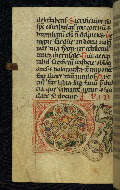
- Title: Initial "Q" with man battling dragon (Quid gloriaris)
- Form: Inhabited initial "Q," 8 lines
- Text: Psalm 51
fol. 56v:
fol. 72r:
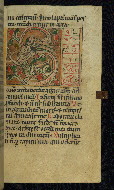
- Title: Initial "S" with man battling dragon (Salvum me)
- Form: Inhabited initial "S," 9 lines
- Text: Psalm 69
fol. 90v:
fol. 108r:
fol. 110v:
fol. 126r:
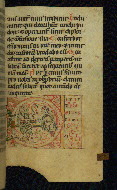
- Title: Initial "D" with God the Father and God the Son (?) (Dixit dominus)
- Form: Historiated initial "D," 8 lines
- Text: Psalm 109
fol. 164v:
The binding is not original.
Sixteenth-century German beech boards, originally covered in brown leather; re-covered in green velvet in the nineteenth century by Léon Gruel, Paris; clasp and catch plates are sixteenth century, poorly refitted
Made for Premonstratensian use (Office of the Dead is of this use), or possibly also Augustinian use (two mentions of Augustine in litany and multiple prayers to the Trinity), probably in Rhineland (litany includes Mosan saints), late twelfth or early thirteenth century
Owned by Rhenish abbeys before French Revolution
Leander van Ess of Darmstadt, acquired from Rhenish abbeys after French Revolution
Sir Thomas Phillipps, 1824, by purchase, no. 441; Ex-libris fol. 1r: rampant lion stamp and inscription "Sir T.P./Middle Hill 441"
Phillipps's sale, London (either 1911, no. 868, or 1913, no. 1021)
Léon Gruel collection, no. 924 (front pastedown)
Henry Walters, Baltimore, acquired from Gruel before 1931
Walters Art Museum, 1931, by Henry Walters' bequest
Ess, Leander van. Sammlung und Verzeichniss handscriftlicher Bücher aus dem VIII. IX. X. XI. XII. XIII. XIV. etc. Jahrhundert: bestehend aus 171 Bänden auf Pergament 19 theils auf Pergament theils auf Papier und 190 auf Papier; nebst einer Sammlung von alten Holzschnitten und kleinen Gemälden mit Vergoldung die leider! aus alten Pergament-Handschriften ausgeschitten sind welche besitzt Leander van Ess Theolog. Doktor Vorrin Professor und Pfarrer in Marburg. Darmstadt, 1823, p. 14, no. 56.
De Ricci, Seymour. Census of Medieval and Renaissance Manuscripts in the United States and Canada. Vol. 1. New York: H. W. Wilson Company, 1935, p. 769, cat. no. 76.
Phillipps, Sir Thomas. The Phillipps Manuscripts: Catalogus librorum manuscriptorum in bibliotheca D. Thomae Phillipps, bt. London: Holland Press, 1968, p. 5, cat. no. 441.
Oliver, Judith. Gothic Manuscript Illumination in the Diocese of Liege (ca. 1250-ca. 1330). 2 vols. Leuven: Uitgeverij Peeters, 1988, p. 137.
Catalogers: Herbert, Lynley; Walters Art Museum curatorial staff and researchers since 1934
Editors: Herbert, Lynley; Noel, William
Copy editor: Dibble, Charles
Conservators: Owen, Linda; Quandt, Abigail
Contributors: Bockrath, Diane; Davis, Lisa Fagin; Dutschke, Consuelo; Emery, Doug; Hamburger, Jeffrey; Klemm, Elizabeth; Mednyanszky, Orsolya; Noel, William; Sciacca, Christine; Tabritha, Ariel; Toth, Michael B.; Valle, Chiara
The Walters Art Museum
Licensed for use under Creative Commons Attribution-NonCommercial-ShareAlike 3.0 Unported Access Rights, http://creativecommons.org/licenses/by-nc-sa/3.0/legalcode. It is requested that copies of any published articles based on the information in this data set be sent to the curator of manuscripts, The Walters Art Museum, 600 North Charles Street, Baltimore MD 21201.
